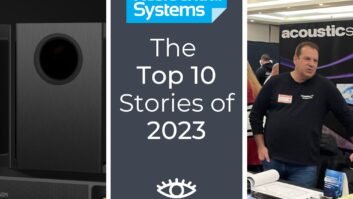Is InfoComm relevant to the residential integrator? It’s a lot like a peanut butter cup.
Anyone who has attended the “Big Two” North American integration tradeshows, InfoComm and CEDIA, has recognized that each has a target demographic. In general terms CEDIA is residential centric and InfoComm heavily tilted toward commercial and live staging.
But a funny thing happened on our way out of a recession, with the housing market in decline and the influx of BYOD gear into commercial spaces, a mixing and overlap occurred. Integration companies who focused on large-scale homes found a need to expand into “light commercial” projects such as huddle spaces, conference rooms, and digital signage.
The influx of normally CEDIA-centric folks, in part, is influencing many of the new product offerings and interoperability concerns exhibited at InfoComm. The combination is a bit of pointing out that our chocolate is in their peanut butter. The reaction of both sides is a bit of umbrage at first but, after tasting, there is genuine delight.
The Integrated Life
Residential installations have always worked on the cutting edge with clients who wanted their visions of seamless control and media distribution met. The same approach applied when companies moved into the commercial space – the mantra of “adapt and apply” ruled the work.
InfoComm has recognized this trend and the rapid acceptance of and direct implementation of IoT devices; in particular the approaching ubiquity of GAFA (Google, Apple, Facebook, and Amazon). The spheres of influence between commercial and residential are a steadily overlapping venn diagram. Increasingly corporate heads want systems that act like and use the interfaces of their homes – they demand a familiar metaphor.
Homeowners are being influenced by the increased access to control technologies they interact with at work and, increasingly, from the hospitality industry. Hotel amenities of room control incorporating smart speakers, IoT key fobs, and shades has generated a desire from consumers to become clients. Having experienced a working “gee-whiz” system using familiar products, a new demographic is now moving from DIY to the “Do It For Me.”
Of Double Duty and Dualities
The evidence goes beyond seminars and talking points, many exhibited products at the show have a definite residential leaning.
Iminate, a company built from members of Colorado Vnet and TiO exhibited a low cost Wifi mesh network system. The products are targeted at the mid-level hospitality and entry-level “custom” home system clients. The line is simple and stark but scalable. Interfacing to GAFA devices currently avoids requiring specific applets, rather it uses IFTT (If This Then That). This “DIY” technology allows the integrator, homeowner, or hotel IT department to create specific applications and keywords.

Google had a booth inside the ‘Integrated Life’ section, which ostensibly featured their cloud and control services (room scheduling, etc.) and content collaborations boards. While the booth focused on education and conference room applications, a few in the booth spoke openly about residential applications that were possible.
RTI (Remote Technologies Inc) showed both commercial and residential applications for its devices. They also showed, and had the main engineer for on hand, what could be a remarkable video over network unit – the Miravue VIP-1 transceiver. The VIP-1 appeared to be one of the few Video over IP units purpose designed to fit both commercial and residential applications.
Control Envy, a company with a serious residential provenance, offers a system translator. Acting something like a protocol Esperanto, the product can coordinate interoperability between major manufacturers of control systems. Control Envy allows for the addition of Arduino-like devices for specialty interfaces and data acquisition and response. It is not far fetched to see such a product being the communication hub between disparte GAFA and IoT-centric systems.
Cutting Edge, Needs Sharper Base
While InfoComm has finally begun to recognize residential integration’s contribution to cutting-edge technology application, we have a great deal to learn from them.
Residential installers still need, on the whole, to get a better grip on networking. Throughout the show, integrators could be heard griping that they did not get into the business to be “mesh network experts.” Ethernet, wired, and wireless are the ubiquitous backbone of nearly all modern systems. Why are we willing to acquiesce the work, and profits, to a third-party IT firm? How long before computer network installers take a greater share of the market. Remember when security installers raised heck over the loss of keypad installs?
We are an analytics industry, or working as an intermediary for one. While it may be easier to just ignore this and pronounce it the responsibility of “others,” it is our systems delivering it. Residential installers, especially those growing into commercial installations, need to come to terms with the technology, its application, and its liabilities. There is great power and opportunity in creating predictive context control and in generating system usage reports. Why would the industry ignore such a paradigm shifting AI tool?
Delightful Duo
InfoComm 2018 has finally begun to fully offer options to residential integrators. While not everyone likes or can even tolerate peanut butter or chocolate, where the combo is appreciated, delight is the result.


